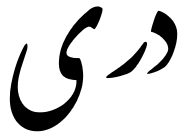Difference between revisions of "Language/Dari/Grammar/Gender"
m (Quick edit) |
m (Quick edit) |
||
| Line 67: | Line 67: | ||
<hr>➡ If you have any questions, please ask them in the comments section below.<br>➡ Feel free to edit this wiki page if you think it can be improved. 😎 | <hr>➡ If you have any questions, please ask them in the comments section below.<br>➡ Feel free to edit this wiki page if you think it can be improved. 😎 | ||
<span class='maj'></span> | |||
==Sources== | |||
* [https://polyglotclub.com/wiki/Language/Dari/Grammar/Gender Dari Grammar - Gender] | |||
* [http://learn101.org/dari_gender.php Dari Gender | LEARN101.ORG] | |||
==Related Lessons== | ==Related Lessons== | ||
Revision as of 14:39, 12 March 2023
Hi Dari learners! 😊
In this lesson, we will focus on the concept of gender in Dari. Gender is an important aspect of language learning as it helps us understand the nature of the noun, and it is also helpful in constructing sentences. This lesson is at an intermediate level, so it is advisable that you already have a basic knowledge of Dari Find native speakers and ask them any questions!
What is gender?
Gender is the characteristic of a noun that reflects the biological sex of the entity it refers to. In Dari, there are two genders - masculine and feminine. However, unlike some languages, gender does not necessarily correspond to the biological sex of the entity it refers to. For example, "the sun" is masculine, and "the moon" is feminine, despite the fact that they are not living creatures. Understanding gender is essential in learning sentence construction in Dari.
Masculine and Feminine Nouns
In Dari, masculine nouns usually end with -و or, in some cases, an "unvoiced" or "soft" ه (h) at the end, while feminine nouns usually end with -ه or an "voiced" or "hard" ه (هٔ) at the end.
Here are some examples of masculine and feminine nouns in Dari:
| Dari | Pronunciation | English |
|---|---|---|
| فرد | /fard/ | man (singular) |
| شاعر | /ʃɒʔer/ | poet (singular) |
| خورشید | /xoɾʃid/ | sun (singular) |
| ایران | /irɒn/ | Iran |
| گل | /ɡul/ | flower (singular) |
| مورچه | /murtʃe/ | ant (singular) |
Suffixes
Many masculine nouns are created from feminine nouns by adding the suffix ژماره, which changes the gender from feminine to masculine.
For example:
- قفسه - cage (feminine)
- قفسهژماره - cage (masculine)
Similarly, many feminine nouns are created from masculine nouns by adding the suffix ژمارهای, which changes the gender from masculine to feminine.
For example:
- معلم - teacher (masculine)
- معلمهای - teacher (feminine)
Dialogue
To give context to these concepts, let's create a dialogue using examples:
- Person 1: او پرنده را قفسهژماره خرید. (/u pærɒnde rɒ ɢæfsehɒmæɾe xæɾid/) (He bought a birdcage.)
- Person 2: آیا پرنده فرد بود؟ (/ɒjɒ pærɒnde fæɾd bu:d/) (Was the bird a male?)
- Person 1: نه، یک ماده خرید. (/ne, jek mædæ xæɾid/) (No, he bought a female one.)
- Person 2: آخه قفسه پرنده هست، چرا ژندر خودش را نداره؟ (/ɒxæ ɢæfseh peærɒnde hast, ʧerɒ ʒendæɾ xodʃ rɒ nedɒɾeh?/) (But a birdcage is not a living thing, why doesn't it have its gender?)
This dialogue illustrates gender and noun usage in contexts relevant to everyday life.
Conclusion
Understanding the gender of nouns is an essential building block in learning Dari grammar. It may seem complicated at first, but with practice and exposure to the language, it becomes more natural. Keep up the good work, and don't forget to always look for ways to improve. 😊
➡ If you have any questions, please ask them in the comments section below.
➡ Feel free to edit this wiki page if you think it can be improved. 😎
Sources
Related Lessons
- Pronouns
- Conditional Mood
- Nouns
- Give your Opinion
- How to Use Have
- Questions
- Plurals
- How to Use Be
- Negation
